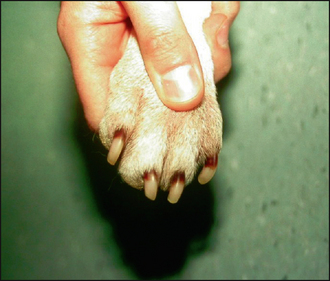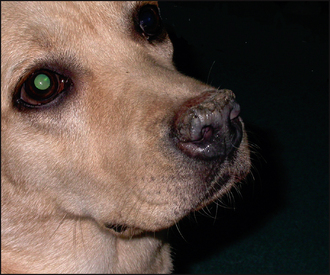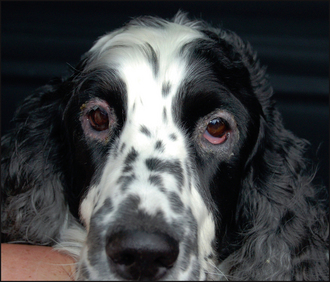50 Dermatoses of specific sites
SITES OF SPECIALIZED STRUCTURE AND FUNCTION
Footpads and nasal planum: The footpads and nasal planum are specially adapted to the function they perform. The footpads have a thick epidermis and an underlying fat pad that protect against mechanical trauma. The nasal planum also has a thick, protective epidermis and, grossly, has a cobblestone appearance. Perhaps in part due to the very thick epidermis, diseases affecting the keratinization process tend to be exaggerated in these sites (Fig. 50.1). The footpads, particularly, are sites of mechanical stress and are susceptible to trauma-exacerbated blistering diseases affecting the basement membrane zone. On the other hand, demodicosis does not occur and dermatophytosis is very rare in these sites, due to the absence of hair follicles.
Claws: Claw anatomy is covered in Chapter 56. There are a wide range of cutaneous and systemic diseases that may directly or indirectly result in claw involvement, in both dogs and cats. The nail folds are a site of bacterial and yeast colonization, and secondary bacterial or yeast paronychia is a frequent finding in many generalized skin diseases (Fig. 50.2). Onychodystrophy is also a feature of many metabolic diseases, including hyperthyroidism in cats and hepatocutaneous syndrome and zinc-responsive dermatosis in dogs. Onychomadesis (loss of nails) may be a manifestation of autoimmune diseases that target the basement membrane. Claw disease, as a sole entity, is relatively uncommon, with a reported incidence of only 1–2% of referral dermatology cases.

Figure 50.2 Malassezia paronychia. Brown staining over the proximal nails is a prominent feature of this disease.
Eyelids: The eyelids are complicated skin folds containing meibomian and Zeis glands that are modified sebaceous glands and the modified sweat glands known as Moll’s glands. Diseases that affect the eyelids can affect tear film production and result in eye involvement. The eyelids are mucocutaneous junctions and the skin is thin and easily damaged by self-trauma. There are a number of generalized skin diseases, including demodicosis, Malassezia dermatitis and pyoderma (Fig. 50.3), and hypersensitivity disorders that produce an exaggerated response in the eyelids and periocular skin. Diseases such as hordeolum, a pyogenic infection of sebaceous glands of the eyelids, and chalazion, a chronic inflammation of meibomian glands, are examples of diseases confined to the eyelids.
Stay updated, free articles. Join our Telegram channel

Full access? Get Clinical Tree




